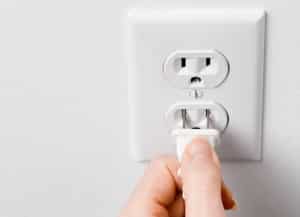
Have you ever heard that appliances and electronic devices still suck power even when they’re turned off? If you’ve imagined this tidbit of information to be just a rumor or some urban legend, it may surprise you that this myth is completely true. At this very second, most if not every device you have plugged into an outlet is drawing power. And yes, it does this even when turned off. We often don’t consider this leaking electricity to have a major impact on our electric bill, but the truth may again surprise you.
According to the US Department of Energy, the average American household uses 11,040 KWh of electricity per year. Out of that figure, a whopping 10% is lost to standby power. Standby power is the term most often used to describe electricity coming into the home but ultimately winds up wasted. Another way to look at just how massive this loss is, consider this; that 10% loss (on a national scale) is the equivalent of running 26 power stations simultaneously 24 hours a day all year long. To put individual losses in terms of dollars, I’ll tell you my own electric company charges $0.0751 per Kilowatt Hour (KWh). So, using figures above, that translates to $82.91 of lost electricity a year in just my household. Suddenly, paying attention to standby power usage means something.
Now that we know what standby power is, and we know it’s not a good thing; we must identify the culprits. As I mentioned at the start, just about everything you have plugged into an outlet is either actively using electricity (such as the computer I’m typing on) or is in standby mode waiting to be used (such as my second computer which is currently shut down). A turned off device is almost never completely turned off. Just because my one computer is shut down doesn’t mean it isn’t drawing power. Internally, that computer is remembering hunks of information and processes so that when it is turned on, everything is ready to go. Additionally, your washer and dryer are no different. It may or may not have a computer brain, but as long as it’s plugged in, electricity is still coming into your home, through the outlet, and into the appliance. So that in a touch of a button or dial, the appliance is ready to operate. The list goes on and on; from your TV and microwave to your security system and even your thermostat and doorbell. One of the biggest mistakes people make is leaving their cell phone charger plugged in. While the phone is connected, we’re making appropriate use of electricity; while the phone is off the charger, and the adapter is still plugged into the wall, we’re very much wasting electricity.
At this point, what’s the solution? How do we limit the use of standby power? The easiest solution is to unplug it. This obviously can’t work for everything, but it’s a grand start. Some items you probably wouldn’t want to unplug such as your alarm clock or an electronic device that receives a constant signal for purposes of automatic updates. But if you can unplug a device or appliance without causing problems to its functionality, then do it. If you can’t or shouldn’t unplug something, try making use of that device’s power save mode. Numerous electronics have this feature including computers and gaming systems. Yet a third solution is to make use of surge protectors or power strips. These items are designed to use very little standby power, and by flipping the off switch of the power strip you are cutting off the standby power to the plugged in device as well.
As I wrap this up, here are just a couple more pointers to reduce your electric bill. First of all, rechargeable batteries are evil. The charger itself is notorious for using standby power. Also, as the batteries get older, they often require longer and more frequent recharges. One example of this is a rechargeable flashlight. Research shows that it’s actually cheaper to own a device that doesn’t charge, and instead uses batteries that must be replaced. Lastly, an easy tip to spot a power-hungry do-nothing is to feel the adapter with your hand. If it’s warm to the touch that usually means it’s guilty of being in a higher standby power mode. Speaking of warm to the touch, if such frugality doesn’t put you in the mood, then may I suggest unplugging the lights and burning some candles.
Image Credit: encangencing